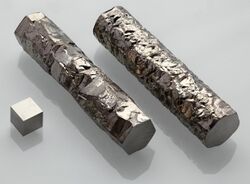Zirconium, 40 Zirconium Pronunciation (zur-KOH -nee-əm Appearance silvery white Standard atomic weight A r, std (Zr) [1] Zirconium in the periodic table
Atomic number (Z ) 40 Group group 4 Period period 5 Block d-block Element category d-block Electron configuration [Kr ] 4d2 5s2 Electrons per shell 2, 8, 18, 10, 2 Physical properties Phase at STP solid Melting point 2128 K (1855 °C, 3371 °F) Boiling point 4650 K (4377 °C, 7911 °F) Density (near r.t. ) 6.52 g/cm3 when liquid (at m.p. ) 5.8 g/cm3 Heat of fusion 14 kJ/mol Heat of vaporization 591 kJ/mol Molar heat capacity 25.36 J/(mol·K) Vapor pressure
P (Pa)
1
10
100
1 k
10 k
100 k
at T (K)
2639
2891
3197
3575
4053
4678
Atomic properties Oxidation states −2, 0, +1,[2] +4 amphoteric oxide) Electronegativity Pauling scale: 1.33 Ionization energies 1st: 640.1 kJ/mol 2nd: 1270 kJ/mol 3rd: 2218 kJ/mol Atomic radius empirical: 160 pm Covalent radius 175±7 pm Spectral lines of zirconiumOther properties Natural occurrence primordial Crystal structure hexagonal close-packed (hcp) Speed of sound thin rod 3800 m/s (at 20 °C) Thermal expansion 5.7 µm/(m·K) (at 25 °C) Thermal conductivity 22.6 W/(m·K) Electrical resistivity 421 nΩ·m (at 20 °C) Magnetic ordering paramagnetic [3] Young's modulus 88 GPa Shear modulus 33 GPa Bulk modulus 91.1 GPa Poisson ratio 0.34 Mohs hardness 5.0 Vickers hardness 820–1800 MPa Brinell hardness 638–1880 MPa CAS Number 7440-67-7 History Naming after zircon , zargun زرگون meaning "gold-colored". Discovery Martin Heinrich Klaproth (1789) First isolation Jöns Jakob Berzelius (1824) Main isotopes of zirconium
Category: Zirconium view · talk · edit references
Zr
data m.p. cat
in
calc from C
diff
report
ref
C
1855
—
—
K
2128
2128
0
F
3371
3371
0
max precision
0
WD
input
C: 1855, K: 2128, F: 3371
comment
Zr
data b.p. cat
in
calc from C
diff
report
ref
C
4377
—
—
K
4650
4650
0
F
7911
7911
0
max precision
0
WD
input
C: 4377, K: 4650, F: 7911
comment
References These references will appear in the article, but this list appears only on this page.
↑ Meija, Juris; Coplen, Tyler B.; Berglund, Michael; Brand, Willi A.; De Bièvre, Paul; Gröning, Manfred; Holden, Norman E.; Irrgeher, Johanna et al . (2016). "Atomic weights of the elements 2013 (IUPAC Technical Report)". Pure and Applied Chemistry 88 (3): 265–91. doi :10.1515/pac-2015-0305 . ↑ "Zirconium: zirconium(I) fluoride compound data" . OpenMOPAC.net. http://openmopac.net/data_normal/zirconium(i)%20fluoride_jmol.html . ↑ Lide, D. R., ed (2005). "Magnetic susceptibility of the elements and inorganic compounds" . CRC Handbook of Chemistry and Physics (86th ed.). Boca Raton (FL): CRC Press. ISBN 0-8493-0486-5 . https://web.archive.org/web/20110303222309/http://www-d0.fnal.gov/hardware/cal/lvps_info/engineering/elementmagn.pdf . ↑ Pritychenko, Boris; Tretyak, V.. "Adopted Double Beta Decay Data" . National Nuclear Data Center. http://www.nndc.bnl.gov/bbdecay/list.html . Retrieved 2008-02-11 . Template:Documentation


